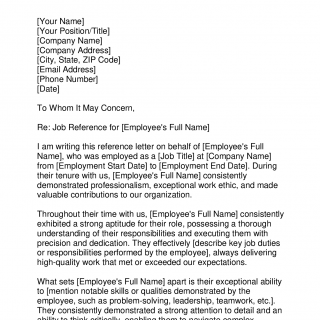Job Reference Letter
The Job Reference Letter is a letter from a former employer that confirms the employment history and performance of an individual, including their job duties, accomplishments, and contributions. The main purpose of this letter is to provide verification and validation of the individual's professional qualifications and work experience.
The letter typically consists of the following parts:
- Salutation: Begin the letter with a professional greeting, addressing the recipient by name or using a general salutation like "To Whom It May Concern."
- Introduction: In the opening paragraph, state the purpose of the letter and provide an introduction to the individual being referenced. Mention the individual's employment dates, job title, and the reporting relationship.
- Job Duties and Responsibilities: In the body of the letter, provide an overview of the individual's job duties, responsibilities, and the scope of their role within the organization. Outline the key functions they performed and any specific projects or initiatives they were involved in.
- Accomplishments and Contributions: Highlight the individual's accomplishments and contributions during their employment. Describe any notable achievements, goals met or exceeded, or innovative ideas implemented. Use specific examples to illustrate their impact and value to the organization.
- Work Performance and Professionalism: Discuss the individual's work performance, professionalism, and overall conduct during their employment. Comment on their punctuality, reliability, teamwork skills, and their ability to meet deadlines or exceed expectations. Highlight their ability to work independently and as part of a team.
- Conclusion and Recommendation: Conclude the letter by summarizing your overall impression of the individual's performance and qualifications. Offer a strong recommendation, endorsing them for any professional opportunities they may be pursuing. Provide contact information should the recipient have any further questions or require additional information.
When writing the Job Reference Letter, it is important to maintain professionalism and provide an accurate and balanced assessment of the individual's qualifications and work performance. It is essential to focus on factual information based on your observations and experiences working with the individual. Proofread the letter for any grammatical or typographical errors before sending or delivering it.
No additional documents are typically required or attached to the Job Reference Letter. However, if the recipient requires further proof of the individual's qualifications or work performance, you may mention supporting documents such as performance evaluations, project reports, or work samples, which can be made available upon request.
Strengths of the Job Reference Letter include providing an objective perspective on an individual's job performance, accomplishments, and contributions. It can significantly enhance their credibility and increase their chances of securing job opportunities.
One potential challenge is ensuring that the information provided is accurate, fair, and does not disclose any confidential or sensitive information without the individual's consent. Employers must be mindful of maintaining privacy and respecting any legal or ethical obligations.
Alternative forms to the Job Reference Letter can include verbal references provided upon request or reference checks made by prospective employers. These forms may lack the comprehensiveness and detail provided in a reference letter.
The Job Reference Letter positively affects the future of the individual by providing validation and verification of their qualifications, work experience, and contributions. It can significantly impact the individual's chances of securing employment or advancing in their careers.
The letter is typically submitted directly to the recipient via mail, email, or as part of a job application. The individual receiving the reference may provide specific instructions or preferred submission methods. Employers may retain the letter in their records or reference database for future use or assessments.

